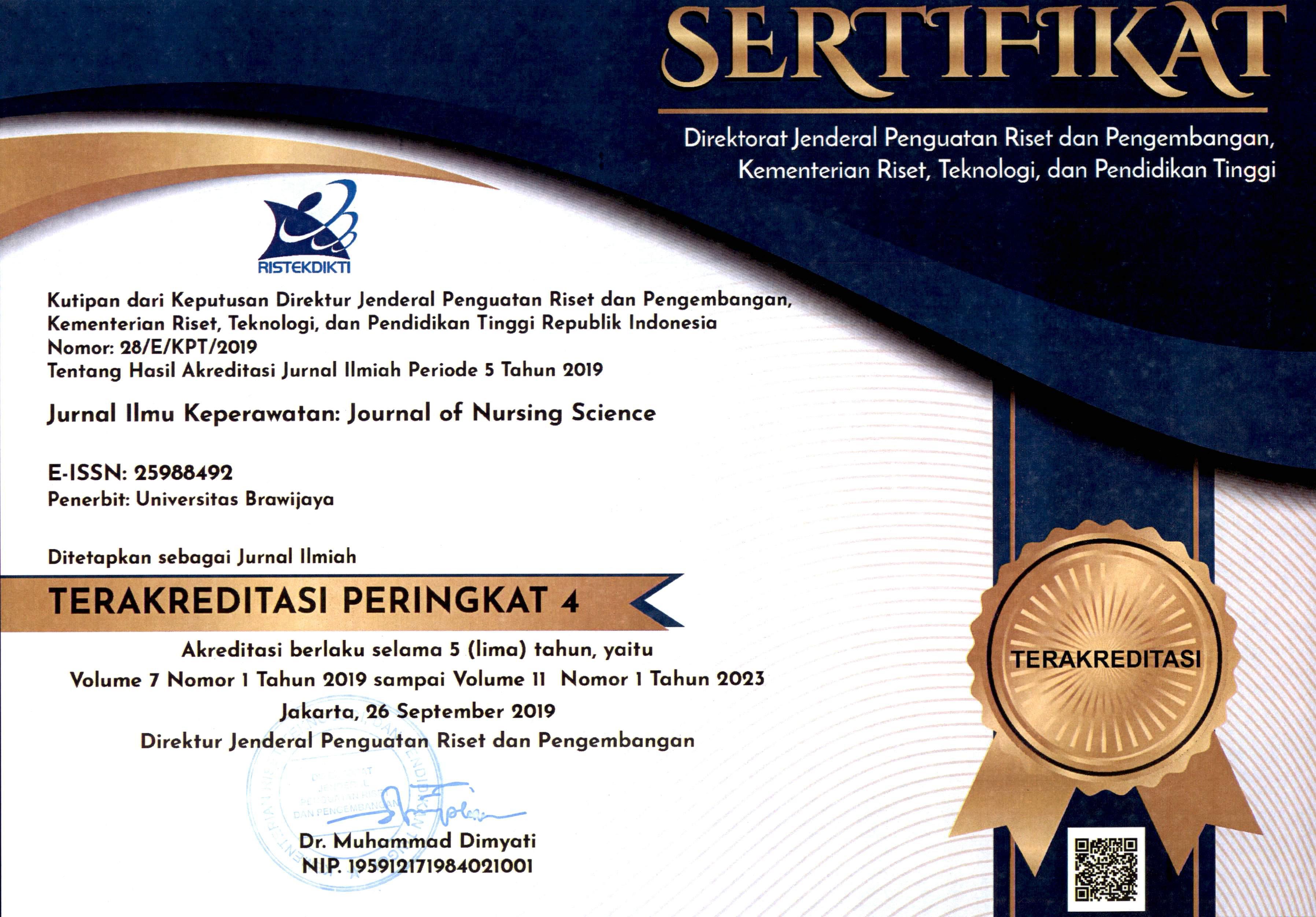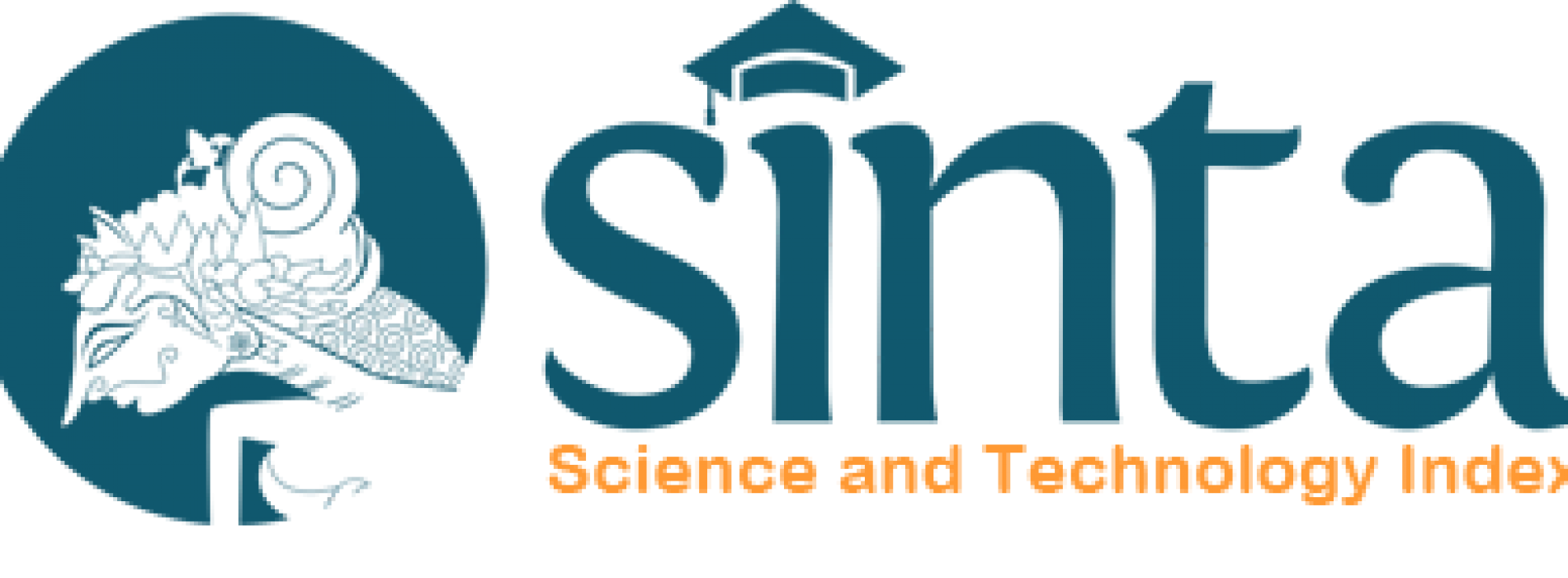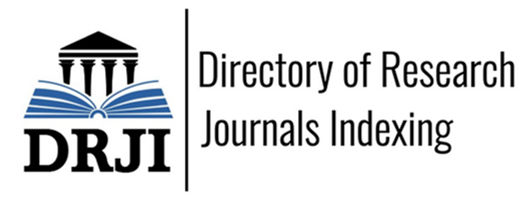EFFECT OF SELF EFFICACY, POSITIVE BELIEF AND SOCIAL SUPPORT ON ROLE ADAPTATION OF POST PARTUM MOTHER WITH POST-TRAUMA STRESS DISORDER (PTSD) IN KEDIRI DISTRICT
DOI:
https://doi.org/10.21776/ub.jik.2017.005.02.9Keywords:
post partum PTSD, role adaptation, self efficacy, positive belief, social supportAbstract
Childbirth is a stressfull event, frequently labor can result PTSD in post partum period. The impact of post partum PTSD is a bonding issue between mother and baby that can affect the mother's ability to adapt to her new role. To Adapting with a new role mother requires an effective coping mechanism that is supported by an adequate coping source that includes self efficacy, positive belief and social support. The study describe the effect of self efficacy, positive belief and social support on adaptation of post partum mother role with PTSD. The study used cross sectional design. The sampling technique was purposive sampling and the numbers of samples were 92 respondents. The instruments for evaluate PTSD and coping was Modified PPQ, Barkin Index, PMP-SE, PPSS and PBRS. Pearson correlation test showed that all variables have p value <0,05, which means that all variables have effect on mother role adaptation. Linear Regression Test showed that self efficacy with R square 0.487 is the variable that most contribute to the mother role adaptation than the others. All variables have contribution, but self efficacy has the most significant influence on mother role adaptation. Therapeutic Activity Therapy in primary setting is needed to help pregnant women prepared adaptation
References
- Alligood, M. R. (2014). Nursing Theorists and Their Work (8th ed.). Philadelpia: Elsevier - Health Sciences Division.
- Ariana, D. N., & Kusumawati, E. (2011). Faktor Risiko Kejadian Persalinan Prematur. Jurnal Unimus.
- Astari, A. S. (2012). Penerapan Konsep Dan Teori Keperawatan Pada Ibu Hamil Dengan Plasenta Previa. Jurnal Keperawatan UMM
- Ayers, S. (2006). The effects of childbirth-related post- traumatic stress disorder on women and their relationships : A qualitative study, (December). http://doi.org/10.1080/13548500600708409
- Ayers, S. (2009). Posttraumatic stress disorder after childbirth: Analysis of symptom presentation and sampling, 200–204. http://doi.org/10.1016/j.jad.2009.02.029
- Azmoude, E., Jafarnejade, F., & Mazlom, S. R. (2015). The Predictors for Maternal Self-efficacy in Early Parenthood. Journal of Midwifery and Reproductive Health, 3(2), 368–376. http://doi.org/10.22038/jmrh.2015.4050
- Beck, C. T. (2010). Subsequent Childbirth. Nursing Research, 59(4), 241–249.
- Beck, C. T. (2015). Middle range theory of traumatic childbirth the ever-widening ripple effect. Global Qualitative Nursing Research, 2, 2333393615575313.
- Beck, C. T., & Watson, S. (2010). Impact of Birth Trauma on Breast-feeding, 57(4), 228–236.
- Beck, C. T., & Watson, S. (2016). “ I Was Broken , Now I Am Unbreakable .†MCN in Advance, 1–6.
- Beninato, J. P. (2012). Beliefs and Coping with Life Stress among UConn Students.
- Boyd, N. G., Lewin, J. E., & Sager, J. K. (2009). A Model Of Stress And Coping And Their Influence On Individual And Organizational Outcomes. Journal of Vocational Behavior, 75(2), 197–211. http://doi.org/http://dx.doi.org/10.1016/j.jvb.2009.03.010
- Brammer, J. L. (2014). In Their Own Words : Healing from Traumatic Childbirth In Their Own Words : Healing from Traumatic Childbirth. Scholar Works, 4.
- Dahlen, H. (2008). The Novice Birthing : Theorising First-Time Mothers ’ Experiences Of Birth At Home And In Hospital In Australia The Novice Birthing : Theorising First-Time Mothers ’, (May). http://doi.org/10.1016/j.midw.2008.01.012
- Elmir, R., Schmied, V., Wilkes, L., & Jackson, D. (2010). Women’s Perceptions And Experiences Of A Traumatic Birth: A Meta-Ethnography. Journal of Advanced Nursing, 66(10). http://doi.org/10.1111/j.1365-2648.2010.05391.x
- Emmanuel, E. N., Creedy, D. K., John, W. S., & Brown, C. (2011). Maternal role development : the impact of maternal distress and social support following childbirth. Midwifery, 27(2), 265–272. http://doi.org/10.1016/j.midw.2009.07.003
- Ford, E., & Ayers, S. (2009). Journal of Anxiety Disorders Stressful events and support during birth : The effect on anxiety , mood and perceived control, 23, 260–268. http://doi.org/10.1016/j.janxdis.2008.07.009
- Gao, L., Sun, K., & Chan, S. W. (2014). Social support and parenting self-efficacy among Chinese women in the perinatal period. Midwifery, 30(5), 532–538. http://doi.org/http://dx.doi.org/10.1016/j.midw.2013.06.007
- Hebert, E. A., Dugas, M. J., Tulloch, T. G., & Holowka, D. W. (2014). Positive beliefs about worry : A psychometric evaluation of the Why. Personality and Individual Differences, 56, 3–8. http://doi.org/10.1016/j.paid.2013.08.009
- Hosseinian, S., Tabatabaei, S., & Ravaei, F. (2011). Effectiveness of supportive psychotherapy on quality of life of women with HIV in Kermanshah. Procedia - Social and Behavioral Sciences, 30, 1902–1907. http://doi.org/10.1016/j.sbspro.2011.10.370
- Iijima, Y., & Tanno, Y. (2013). The moderating role of positive beliefs about worry in the relationship between stressful events and worry. Personality and Individual Differences, 55(8), 1003–1006. http://doi.org/10.1016/j.paid.2013.08.004
- Klossner, N. J. (2006). Introductory Maternity Nursing. Lippincott Williams & Wilkins.
- Leahy-Warren, P., & McCarthy, G. (2017). Maternal parental self-efficacy in the postpartum period. Midwifery, 27(6), 802–810. http://doi.org/10.1016/j.midw.2010.07.008
- Leahy-warren, P., Mccarthy, G., & Corcoran, P. (2011). First-time mothers : social support , maternal parental self-efficacy and postnatal depression, 388–397. http://doi.org/10.1111/j.1365-2702.2011.03701.x
- Leerkes, E. M., & Burney, R. V. (2007). The Development of Parenting Efficacy Among New Mothers and Fathers. Infancy, 12(1), 45–67. http://doi.org/10.1111/j.1532-7078.2007.tb00233.x
- Lestari, M. S. (2014). Peran Kepribadian Terhadap Proses Coping Stress Pada Ibu Rumah Tangga Pengidap HIV / AIDS Peran Kepribadian Terhadap Proses Coping Stress Pada Ibu Rumah Tangga Pengidap HIV / AIDS.
- Littleton-Gibbs, L. Y., & Engebretson, J. (2012). Maternity Nursing Care. Cengage Learning.
- Lowdermilk, D. L., Perry, S. E., & Cashion, M. C. (2013). Maternity Nursing. Elsevier Health Sciences.
- McEwen, M., & Wills, E. M. (2011). Theoretical Basis for Nursing. Wolters Kluwer/Lippincott Williams & Wilkins.
- Mckenzie-mcharg, K., Ayers, S., Ford, E., Horsch, A., Sawyer, A., Stramrood, C., … Slade, P. (2015). Post-traumatic stress disorder following childbirth : an update of current issues and recommendations for future research, 6838(May 2016). http://doi.org/10.1080/02646838.2015.1031646
- Müller, D., Teismann, T., Havemann, B., Michalak, J., & Seehagen, S. (2013). Ruminative Thinking as a Predictor of Perceived Postpartum Mother–Infant Bonding. Cognitive Therapy and Research, 37(1), 89–96. http://doi.org/10.1007/s10608-012-9454-7
- Negron, R., Martin, A., Almog, M., Balbierz, A., & Howell, E. A. (2013). Social Support During the Postpartum Period: Mothers’ Views on Needs, Expectations, and Mobilization of Support. Maternal and Child Health Journal, 17(4), 616–623. http://doi.org/10.1007/s10995-012-1037-4
- Nichols, K., & Ayers, S. (2007). Chilbirth related post traumatic stress dissorder in couple. Birth, 34, 253–263. http://doi.org/10.1111/j.1523-536X.2007.00178.x
- Nilsson, C., & Lundgren, I. (2009). Women ’ s lived experience of fear of childbirth. Midwery, 25, 1–9. http://doi.org/10.1016/j.midw.2007.01.017
- Olde, E., Hart, O. Van Der, Kleber, R., & Son, M. Van. (2006). Posttraumatic stress following childbirth : A review, 26, 1–16. http://doi.org/10.1016/j.cpr.2005.07.002
- Olley, B. O., Reid, E., & Chb, M. B. (2004). articles Psychopathology and coping in recently diagnosed HIV / AIDS patients — the role of gender, 10(1), 21–24.
- Paczkowski, E., & Baker, B. L. (2010). Parenting Children with Developmental Delays: The Role of Positive Beliefs, 1(3), 1–20. http://doi.org/10.1080/19315860801988392.Parenting
- Roussis, P., & Wells, A. (2006). Post-traumatic stress symptoms : Tests of relationships with thought control strategies and beliefs as predicted by the metacognitive model, 40, 2005–2007. http://doi.org/10.1016/j.paid.2005.06.019
- Sarafino, E. P., & Smith, T. W. (2014). Health Psychology: Biopsychosocial Interactions. Wiley.
- Schwab, W., Marth, C., & Bergant, A. M. (2012). Post-traumatic Stress Disorder Post Partum: The Impact of Birth on the Prevalence of Post-traumatic Stress Disorder (PTSD) in Multiparous Women. Geburtshilfe Und Frauenheilkunde, 72(1), 56–63. http://doi.org/10.1055/s-0031-1280408
- Serçekuş, P., & Başkale, H. (2016). Effects of antenatal education on fear of childbirth, maternal self-efficacy and parental attachment. Midwifery, 34, 166–172. http://doi.org/http://dx.doi.org/10.1016/j.midw.2015.11.016
- Shaban, Z., Dolatian, M., Shams, J., Alavi-Majd, H., Mahmoodi, Z., & Sajjadi, H. (2013). Post-Traumatic Stress Disorder (PTSD) Following Childbirth: Prevalence and Contributing Factors. Iranian Red Crescent Medical Journal, 15(3), 177–182. http://doi.org/10.5812/ircmj.2312
- Stuart, G. W. (2014). Principles and Practice of Psychiatric Nursing. Elsevier Health Sciences.
- Taghizadeh, Z., Irajpour, A., & Arbabi, M. (2013). Mothers ’ Response to Psychological Birth Trauma : A Qualitative Study. Iranian Red Cresent Medical Journal, 15(10), 1–7. http://doi.org/10.5812/ircmj.10572
- Takehara, K., Noguchi, M., Shimane, T., & Misago, C. (2014). A longitudinal study of women ’ s memories of their childbirth experiences at five years postpartum. BMC Pregnancy and Childbirth, 14, 1–7.
- Taylor, S. E., & Stanton, A. L. (2007). Coping Resources , Coping Processes , and Mental Health, 377–403. http://doi.org/10.1146/annurev.clinpsy.3.022806.091520
- Thomson, G., & Dowe, S. (2009). Widening the trauma discourse: The link between childbirth and experiences of abuse. Journal of Psychosomatic Obstetrics & Ginecology, 29(4), 268–273. http://doi.org/10.1080/01674820802545453
- Tomaka, J., Thompson, S., & Palacios, R. (2014). The Relation of Social Isolation, Loneliness, and Social Support to Disease Outcomes Among the Elderly. JUrnal of Aging and Health, 38(356). http://doi.org/10.1177/0898264305280993
- Verreault, N., Da, D., Marchand, A., Ireland, K., Banack, H., Dritsa, M., & Khalifé, S. (2012). PTSD following childbirth : A prospective study of incidence and risk factors in Canadian women. Journal of Psychosomatic Research, 73(4), 257–263. http://doi.org/10.1016/j.jpsychores.2012.07.010
- Yelland, J., Sutherland, G., & Brown, S. J. (2010). Postpartum anxiety , depression and social health : findings from a population-based survey of Australian women. BMC Public Health, 10(1), 771. http://doi.org/10.1186/1471-2458-10-771
Downloads
Published
How to Cite
License
Authors published in this journal agree to the following terms:
1. The copyright of the received article shall be assigned to the journal as the publisher of the journal. The intended copyright includes the right to publish the article in various forms (including reprints). The journal maintains the publishing rights to the published articles.
2. Authors may enter into separate additional contractual agreements for the non-exclusive distribution of the published journal version of the work (for example, posting it to an institutional repository or publishing it in a book), with acknowledgment of their initial publication in this journal.
3. Authors are permitted and encouraged to post their work online (e.g. in an Institutional Repository or on their website) before and during the submission process, as this can result in a productive exchange, as well as earlier and larger citations of the published work.
4. Articles and all related material published are distributed under Creative Commons Attribution-NonCommercial 4.0 International License or CC BY-NC 4.0 license.
JNSU is licensed under a Creative Commons Attribution-NonCommercial 4.0 International License or CC BY-NC 4.0 license.
Most read articles by the same author(s)
- Putri Ragil Kusumawardani, Sri Poeranto, Asti Melani Astari, THE RELATIONSHIP BETWEEN POST PARTUM DEPRESSION WITH MOTHER-BABY EMOTIONAL BONDING, BREASTFEEDING ABILITY, MARRIAGE SITUATION RELATIONSHIP IN PUSKESMAS MALANG REGION , Journal of Nursing Science Update (JNSU): Vol. 5 No. 2 (2017)
- Farida Maemunah Martiningsih, Retty Ratnawati, Asti Melani Astari, DIFFERENCES EFFECT OF PROGRESSIVE MUSCLE RELAXATION THERAPY AND SUPPORTIVE THERAPY ON PARENTS ANXIETY WITH CHILDREN HOSPITALIZATION AT RSUD.DR.R.SOEDJONO SELONG EAST LOMBOK , Journal of Nursing Science Update (JNSU): Vol. 6 No. 1 (2018)
- Asti Melani Astari, Nurul Evi, Muladefi Choiriyah, Puji Ariyani, Anif Lailatul Fitriy, Analysis of Differences in Individual Characteristics, Lifestyle, Nutritional Status and Dieting Patterns in Pregnant Women with Preeclampsian History , Journal of Nursing Science Update (JNSU): Vol. 9 No. 1 (2021)
- Ayut Merdikawati, Eka Nurjannah, Asti Melani Astari, Muladefi Choiriyah, Factors Affecting Antenatal Care Visit Obedience during the Covid-19 Pandemic in Konawe District, Southeast Sulawesi , Journal of Nursing Science Update (JNSU): Vol. 10 No. 1 (2022): May





























